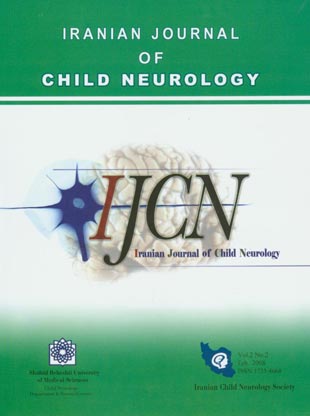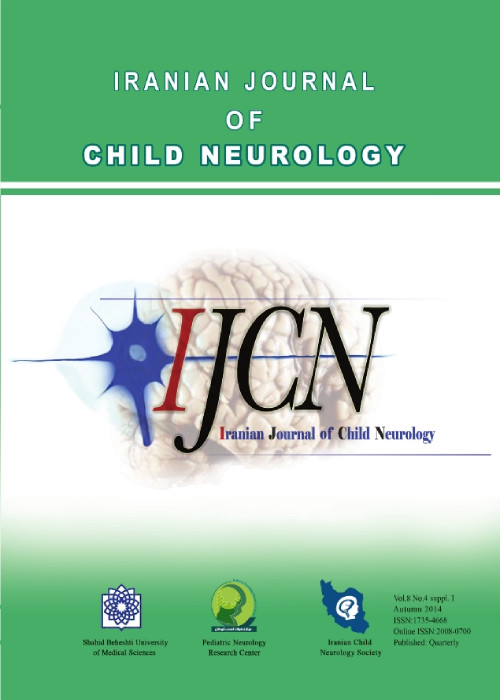فهرست مطالب

Iranian Journal of Child Neurology (IJCN)
Volume:2 Issue: 2, Spring 2008
- 54 صفحه،
- تاریخ انتشار: 1387/02/10
- تعداد عناوین: 9
-
-
Page 7Minor trauma to the head is common in childhood and does not requireany medical or surgical treatment. Nevertheless, head injury in infancyand childhood is the single most common cause of death and permanentdisability. Measurable deficits occur even after mild to moderate head injurybut are markedly greater after severe injury. They include impaired cognition,motor impairments, disruption of attention and information processing, andpsychiatric disturbances. Despite the frequency of the sequelae of head injuryin childhood, there is relatively little information about the structural basisof the clinical deficits. Classical literature suggests that the immature brainand its coverings, at a time when it is rapidly acquiring new information,respond differently from the adult brain when subjected to an equivalentamount of mechanical force, whether mediated by contact or inertial loading.Identification of different patterns of injury in different age groups has resonancein clinical practice and now provides a reference point for future clinical andneuropathological studies. This work not only provides the basis for the futuremanagement of patients, but also serves to remind us of the continuing valueof the autopsy and the proper examination of retained organs using modernstandardized techniques.
-
Page 15ObjectiveThe aim of this study was to evaluate and compare the effects of Na Valproateand Phenobarbital on changes in the weight of epileptic patients followingtreatment for their condition using the drugs mentioned.Materials and methodsSixty epileptics were assigned into two groups of 30 patients each, the caseand controls. The diagnosis was made on the basis of the InternationalLeague Against Epilepsy (ILAE) characteristics. BMI was defined. In the casegroup, the patients received 20mg/kg/day of Na Valproate, while the 30controls received 5mg/kg/day of Phenobarbital for 6 months. Using the McNemar and Chi-2 tests, BMI changes were compared after 6 months betweenthe groups. Fisher’s exact test was used to evaluate the role of age, sex, andprimary weight on the weight increase due to Na Valproate usage.ResultsThere were no specific changes in age, sex, primary BMI and fatness betweenthe 2 groups; in the case group, 20 patients(66.7%) and in the controls 4(13.3%)gained weight (P<0.001). There were higher chances of weight gain in childrenwho were older and fatter at the beginning of the study (P<0.2).ConclusionThe results indicate that epileptic children, aged over 10 years, and thosewho are overweight have more chances of gaining weight or becoming fatter,following treatment with Na Valproate. Further studies investigating the issueare warranted.
-
Page 19ObjectiveTo study the clinical presentation, hospital course and outcomes of patientsadmitted with Guillain-Barre Syndrome (GBS) to three tertiary care hospitals inMashhad, Iran.Materials and MethodsThe records of all patients admitted with flaccid paralysis between April 1999and January 2005 were reviewed and those with the diagnosis of GBS wereincluded in the study. Standard questionnaires were used to record clinical dataon was recorded on a standardized questionnaire, which included patients’age, sex, antecedent infectious history, neurological signs and symptoms andventilation requirements. The hospital course, including therapy given and thefunctional status of patients, was analyzed, including therapy given and thefunctional status of patients.ResultsNinety-one cases of acute flaccid paralysis were admitted to the hospitals duringthe study period. Eighty-three cases, age range 10 months to 11 years, were laterdiagnosed as GBS afterwards, with an age range of 10 months to 11 years. Themean age for disease onset was 4.2 years; there were 47 boys and 34 girls, maleto female ratio 1:0.7. Upper respiratory tract infection (62.6%) was the mostcommon antecedent event, followed by gastrointestinal infections (19%), urinarytract infection (1.2%) and chicken pox (2.4%), while the remaining cases (14.8%)had no other cases (14.8%) did not have any reliable history of any precedingantecedent infections. Most patients developed GBS within one month of thepreceding infection. Cranial nerve abnormalities (19.3%), autonomic dysfunction(7.2%) and respiratory failure requiring intubation (10.8%) were also common.The in-patient mortality was 2.4% (2 of 83).ConclusionGBS was found to occur slightly more often in male patients, majority of whomhad histories of previous infection. Despite persistent disability, in-hospitalmortality was low.
-
Page 23ObjectiveThe aim of the present study was to evaluate the etiology and frequency ofneonatal seizure in hospitalized neonates.Materials and MethodsIn this descriptive, cross-sectional study, we evaluated 1295 neonates withseizures admitted to neonatal and NICU wards in our center. Data was collectedon age, sex, birth weight, serum levels of calcium, glucose, and sodium, CTscan findings, history of maternal opium abuse, blood and cerebrospinal fluidculture, and analyzed using SPSS 13.ResultsOf a total of 1295 patients, 34 (2.62%) had seizure. Mean age was 14.03 ±10.05 days (range, 1 to 29 days); twenty-five (73.5%) neonates were boys and9 (26.5%) were girls. Of 34 neonates with neonatal seizures, 12 (35.3%), 11(32.4%), 9 (26.5%), 7 (20.6%), and 3 (8.8%) had hypocalcemia, asphyxia,hypoglycemia, intracranial hemorrhage, and hypernatremia, respectively.Maternal addiction, meningitis, and sepsis were found in 3 (8.8%), 1 (2.9%)and 1 (2.9%) of neonates, respectively.ConclusionThe incidence rate of neonatal seizure in the neonates in our NICU and neonatalward was 2.62%. Common causes of seizure in this study included hypocalcemia,asphyxia, hypoglycemia, intracranial hemorrhage, and hypernatremia. Maternaladdiction, meningitis and sepsis had the lowest prevalence.
-
Page 27ObjectiveSub acute Sclerosing Pan Encephalitis (SSPE), a progressive neurological disordercharacterized by inflammation of the brain (encephalitis), is the result of aninappropriate immune response to the measles virus or measles vaccination.SSPE usually develops 2 to 10 years after the original viral attack. Some of themajor signs and symptoms are mental deterioration, jerky movements, andseizures specially myoclonic type, involuntary movements, and/or behavioralchanges, difficulty in walking, speech, and loss of cognition, respiratory distressand death.Materials and MethodsDuring the ten years, from July 1991 to July 2001, we admitted 45 cases of(SSPE), at different stages of the disorder. Regardless of their stage of disease,for intervention, randomly, we used one of three drugs; Amantadin, Interferonalfa and Isoprinosine, administered to the patients, for between one month toone year. Fourteen cases received Amantadin, 15 Alfa interferon, and 16 weregiven Isoprinosine.ResultsWhile the results show all three drugs to be relatively effective, Isoprinosineshowed four times more effectiveness than Amantadin and twice as much asInterferon.ConclusionThe results showed Isoprinosine to be much more effective than Amantadinand Alfa interferon in treating the condition.
-
Page 33ObjectiveCerebral palsy (CP), a common static motor neurological disorder of childhoodwith wide spectrum of underlying etiologies, can be demonstrated withdifferent neuro imaging techniques. We undertook this study to investigatethe diagnosis of intracranial lesions in children with CP and its correlationbetween clinical deficits and neuroradiological findings.Materials and methodsIn this prospective hospital-based study, the data of 120 patients with CP,aged below 18 years, referring to the neurology clinic of the Ali AsgharPediatric hospital in Tehran was studied; data on their cranial neuroimagingfindings was analyzed any possible association(s) between the gestationalages, prenatal history and neurological deficits were investigated.ResultsOf the 120 patients, 72 (60%) were male; 75% were aged below 7 years.Common predisposing factors were prenatal asphyxia, LBW, prematurityand toxemia of pregnancy. Of the 120 cases, 90%(107) had spastic CP, withthe quadriplegic type being the most common (54%), followed by spasticparaplegia (21%); twenty-four patients (20%) had significant PreventricularLeucomalacia (PVL), a finding more common among those born pre-term.Sixteen patients had hemiplegic CP, 14 of whom showed unilateral lesionson brain MRI imaging. Ten (8%) had extra pyramidal CP, a condition morecommon among term born infants, while six of the 10(72%) showed significantabnormalities on the basal ganglia. Cerebral atrophy was seen in 60 (50%) ofpatients and PVL in 20%; encephalomalacia, gliosis, middle cerebral arteryinfarcts, PVL and gliosis indicated hypoxia as a risk factor for CP. Extent ofMRI lesions correlated with the severity of neurological deficits in CP lesions,which were more extensive in Quadriplegics and double hemiplegics ratherthan paraplegics, and among those delivered preterm as compared to thoseborn at term.ConclusionRadiological findings were found to be closely related to the type of CP andthe neurological deficits and gestational ages of patients with brain insult;we believe that MRI is helpful in delineating the underlying etiology, extent,severity and timing of insult to the developing brain and prognostication in
-
Page 39ObjectiveNeonates, for many reasons, are at particular risk for the development ofseizures, which are a strong predictor of later morbidity and mortality ininfants.We undertook this study to determine the incidence, etiologic distributionand neonatal seizure type in neonates with hospital admission over a periodof 4 years.Materials and MethodsThis, a retrospective study of newborns admitted in hospital with a diagnosisof neonatal seizures, was conducted over a 4 year period between March2001 and March 2005.Data were obtained from hospital records was analyzed using the Chi-squaretest.ResultsOf 4541 newborns, admitted to hospital, during the study period, seizuresoccurred in 110 neonates. The incidence of neonatal seizures was 2.4%; thecauses of neonatal seizure were Hypoxic-Ischemic Encephalopathy (HIE)- 36.4%, infections -19.1%, metabolic abnormalities - 7.3%, Intra CranialHemorrhage (ICH) - 2.7%, structural disorders - 1.8% and in 32.7% of cases,the cause was unknown.Subtle seizures (39.1%) were the most common type of seizures; and the othertypes were myoclonic (17.3%), clonic (10.0%), Tonic (7.3%), GeneralizedTonic Clonic Seizures (GTCS) (12.7%) and in 13.6% of cases the type ofseizure was not mentioned. Mortality rate was 13.6%.ConclusionHealth care workers and parents need to be made aware of subtle seizuresand the importance of timely and appropriate treatment to decrease anyfurther complications.
-
Page 43ObjectiveBotulism is the acute, descending, flaccid paralysis that results when the neurotoxin of Clostridium botulinum blocks neuromuscular transmission. C botulinum toxin is the most poisonous substance that blocks neuromuscular transmission and causes death through airway and respiratory muscle paralysis; all forms of botulism manifest neurologically as asymmetric, descending, flaccid paralysis beginning with the cranial nerve musculature. Food-borne botulism results from the ingestion of food in which C botulinum has multiplied and produced its toxin.PatientWe report a new case of food-borne botulism in a 7 year old boy with recurrentepisodes of weakness, difficulty in swallowing and speech; bilateral ptosis andmydriasis. He had positive history of the same symptoms, documented twicebefore. The patient’s samples were sent for detection of toxin of Clostridiumbotulinum, and toxin of C. botulinum, type A was found in his stool sample,confirming our diagnosis. This case was unusual report because our patient hasnot history of canned food ingestion and also because recurrent episodes ofparalysis in this case are unusual findings in botulism.ConclusionIn this report we want to emphasize that canned-food ingestion is not necessaryfor diagnosis of food-borne botulism and because delayed treatment leads toincrease mortality and morbidity, treatment should be initiated promptly on thebasis of clinical suspicion.
-
Page 47Mitochondrial myopathy, lactic acidosis, and sideroblastic anemia (MLASA)syndrome is a rare autosomal recessive disorder of oxidative phosphorylationand iron metabolism. The association between myopathy and sideroblasticanemia was initially reported in 1974. Here we report an 8.5 year old boywith normal cognitive function, suffering from chronic progressive weaknessin his lower extremities, inability to walk and palor. Microcytic sideroblasticanemia, mild lactic acidosis and inflammatory myopathy (myositis) in musclebiopsy was detected and treated; the response to corticosteroid therapyand rehabilitation was excellent and the patient was ambulatory after fourmonths.


